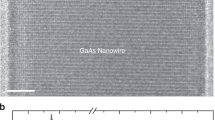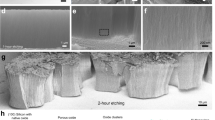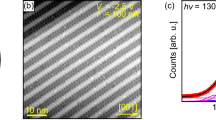Abstract
The potential for the metal nanocatalyst to contaminate vapour–liquid–solid grown semiconductor nanowires has been a long-standing concern, because the most common catalyst material, Au, is highly detrimental to the performance of minority carrier electronic devices. We have detected single Au atoms in Si nanowires grown using Au nanocatalyst particles in a vapour–liquid–solid process. Using high-angle annular dark-field scanning transmission electron microscopy, Au atoms were observed in higher numbers than expected from a simple extrapolation of the bulk solubility to the low growth temperature. Direct measurements of the minority carrier diffusion length versus nanowire diameter, however, demonstrate that surface recombination controls minority carrier transport in as-grown n-type nanowires; the influence of Au is negligible. These results advance the quantitative correlation of atomic-scale structure with the properties of nanomaterials and can provide essential guidance to the development of nanowire-based device technologies.
This is a preview of subscription content, access via your institution
Access options
Subscribe to this journal
Receive 12 print issues and online access
$259.00 per year
only $21.58 per issue
Buy this article
- Purchase on Springer Link
- Instant access to full article PDF
Prices may be subject to local taxes which are calculated during checkout





Similar content being viewed by others
References
Cui, Y. & Lieber, C. M. Functional nanoscale electronic devices assembled using silicon nanowire building blocks. Science 291, 851–853 (2001).
Beckman, R., Johnston-Halperin, E., Luo, Y., Green, J. E. & Heath, J. R. Bridging dimensions: Demultiplexing ultrahigh-density nanowire circuits. Science 310, 465–468 (2005).
Huang, Y. et al. Logic gates and computation from assembled nanowire building blocks. Science 294, 1313–1317 (2001).
Patolsky, F. et al. Detection, stimulation, and inhibition of neuronal signals with high-density nanowire transistor arrays. Science 313, 1100–1104 (2006).
Xiang, J. et al. Ge/Si nanowire heterostructures as high-performance field-effect transistors. Nature 441, 489–493 (2006).
Huang, Y., Duan, X. F., Wei, Q. Q. & Lieber, C. M. Directed assembly of one-dimensional nanostructures into functional networks. Science 291, 630–633 (2001).
Jin, S. et al. Scalable interconnection and integration of nanowire devices without registration. Nano Lett. 4, 915–919 (2004).
Javey, A., Nam, S., Friedman, R. S., Yan, H. & Lieber, C. M. Layer-by-layer assembly of nanowires for three-dimensional, multifunctional electronics. Nano Lett. 7, 773–777 (2007).
Wagner, R. S. & Ellis, W. C. Vapor–liquid–solid mechanism of single crystal growth. Appl. Phys. Lett. 4, 89–90 (1964).
Cui, Y., Lauhon, L. J., Gudiksen, M. S., Wang, J. F. & Lieber, C. M. Diameter-controlled synthesis of single-crystal silicon nanowires. Appl. Phys. Lett. 78, 2214–2216 (2001).
Gudiksen, M. S., Lauhon, L. J., Wang, J., Smith, D. C. & Lieber, C. M. Growth of nanowire superlattice structures for nanoscale photonics and electronics. Nature 415, 617–620 (2002).
Lauhon, L. J., Gudiksen, M. S., Wang, C. L. & Lieber, C. M. Epitaxial core–shell and core–multishell nanowire heterostructures. Nature 420, 57–61 (2002).
Sprokel, G. J. & Fairfield, J. M. Diffusion of gold into silicon crystals. J. Electrochem. Soc. 112, 200–203 (1965).
Bullis, W. M. Properties of gold in silicon. Solid State Electron. 9, 143–168 (1966).
Wang, Y., Schmidt, V., Senz, S. & Gosele, U. Epitaxial growth of silicon nanowires using an aluminium catalyst. Nature Nanotech. 1, 186–189 (2006).
Shchetinin, A. A. et al. Distribution coefficient of the initiating impurity and its influence on the electrical-resistivity of filamentary silicon-crystals. Inorgan. Mater. 27, 1137–1139 (1991).
Voyles, P. M., Muller, D. A., Grazul, J. L., Citrin, P. H. & Gossmann, H. J. L. Atomic-scale imaging of individual dopant atoms and clusters in highly n-type bulk Si. Nature 416, 826–829 (2002).
Stolwijk, N. A., Schuster, B. & Holzl, J. Diffusion of gold in silicon studied by means of neutron-activation analysis and spreading-resistance measurements. Appl. Phys. A Mater. Sci. Process. 33, 133–140 (1984).
Wu, Y. et al. Controlled growth and structures of molecular-scale silicon nanowires. Nano Lett. 4, 433–436 (2004).
Kodambaka, S., Tersoff, J., Reuter, M. C. & Ross, F. M. Germanium nanowire growth below the eutectic temperature. Science 316, 729–732 (2007).
Reitano, R., Smith, P. M. & Aziz, M. J. Solute trapping of group-III, IV, and V elements in silicon by an aperiodic stepwise growth-mechanism. J. Appl. Phys. 76, 1518–1529 (1994).
Perea, D. E. et al. Three-dimensional nanoscale composition mapping of semiconductor nanowires. Nano Lett. 6, 181–185 (2006).
Ioannou, D. E. & Dimitriadis, C. A. A SEM-EBIC minority-carrier diffusion-length measurement technique. IEEE Trans Electron. Dev. 29, 445–450 (1982).
Hannon, J. B., Kodambaka, S., Ross, F. M. & Tromp, R. M. The influence of the surface migration of gold on the growth of silicon nanowires. Nature 440, 69–71 (2006).
Kodambaka, S., Hannon, J. B., Tromp, R. M. & Ross, F. M. Control of Si nanowire growth by oxygen. Nano Lett. 6, 1292–1296 (2006).
Daiminger, F., Schmidt, A., Faller, F. & Forchel, A. Picosecond time resolved investigations of carrier lifetime and carrier capture in InGaAs/GaAs quantum dots. Proc. SPIE 2139, 213–221 (1994).
Klaassen, D. B. M. A unified mobility model for device simulation .2. Temperature-dependence of carrier mobility and lifetime. Solid State Electron. 35, 961–967 (1992).
Gray, P. V. & Brown, D. M. Density of SiO2–Si interface states. Appl. Phys. Lett. 8, 31–33 (1966).
Seo, K. I., Sharma, S., Yasseri, A. A., Stewart, D. R. & Kamins, T. I. Surface charge density of unpassivated and passivated metal-catalyzed silicon nanowires. Electrochem. Solid State Lett. 9, G69–G72 (2006).
Haick, H., Hurley, P. T., Hochbaum, A. I., Yang, P. D. & Lewis, N. S. Electrical characteristics and chemical stability of non-oxidized, methyl-terminated silicon nanowires. J. Am. Chem. Soc. 128, 8990–8991 (2006).
Perea, D. E., Lensch, J. L., May, S. J., Wessels, B. W. & Lauhon, L. J. Composition analysis of single semiconductor nanowires using pulsed-laser atom probe tomography. Appl. Phys. A Mater. Sci. Process. 85, 271–275 (2006).
Acknowledgements
The work at Northwestern was supported by the National Science Foundation (NSF) through the Materials Research Science and Engineering Center (MRSEC) (J.A.), CAREER (L.L.), NIRT (E.H.) and Graduate Research Fellowship (J.L.) programmes; the Office of Naval Research and a Ford Foundation Fellowship (D.P.); and an Alfred P. Sloan Research Fellowship (L.L.). E.H. acknowledges a travel grant from the Northwestern University Nanoscale Science and Engineering Center (NSEC). We acknowledge the Northwestern University Center for Atom -- Probe Tomography facility and the Northwestern University Atomic- and Nanoscale Characterization Experimental Center (NUANCE). The NUANCE Center is supported by NSF-NSEC, NSF-MRSEC, the Keck Foundation, the State of Illinois and Northwestern University. The work at Birmingham and Daresbury was supported by the Engineering and Physical Sciences Research Council.
Author information
Authors and Affiliations
Contributions
J.A. and E.H. contributed equally to this work. J.A. performed the device experiments and analysed the data with L.L. D.P. performed the atom probe experiments and analysed the data with L.L. E.H. and J.L. synthesized the materials. The STEM work and analysis were conducted by the Birmingham-SuperSTEM collaboration (Z.Y.L, F.Y, R.E.P., M.H.G., P.W. and A.L.B.) in association with the Northwestern group (E.H. and L.L.). L.L. coordinated the design and execution of the experiments. J.A. and L.L. co-wrote the paper. All authors discussed the results and commented on the manuscript.
Corresponding author
Supplementary information
Supplementary Information
Supplementary figure S1–S4 and supplementary text S1–S5 (PDF 1422 kb)
Rights and permissions
About this article
Cite this article
Allen, J., Hemesath, E., Perea, D. et al. High-resolution detection of Au catalyst atoms in Si nanowires. Nature Nanotech 3, 168–173 (2008). https://doi.org/10.1038/nnano.2008.5
Received:
Accepted:
Published:
Issue Date:
DOI: https://doi.org/10.1038/nnano.2008.5
This article is cited by
-
Tannic acid coated single-wall carbon nanotube membranes for the recovery of Au from trace-level solutions
Nano Research (2023)
-
Development and characterization of photovoltaic tandem-junction nanowires using electron-beam-induced current measurements
Nano Research (2022)
-
Self-organization of various “phase-separated” nanostructures in a single chemical vapor deposition
Nano Research (2020)
-
Photocatalytic Stille Cross-coupling on Gold/g-C3N4 Nano-heterojunction
Chemical Research in Chinese Universities (2020)
-
Graphene-supported metal single-atom catalysts: a concise review
Science China Materials (2020)



